演讲技巧
演讲小技巧(精选18篇)

演讲小技巧〔精选18篇〕演讲小技巧〔精选18篇〕演讲小技巧篇1演讲是需要天赋也需要锻炼的一种才能,有的人在演讲时可以侃侃而谈,带给众人精彩的表演。
也有的人害怕演讲,在众目睽睽之下紧张得冒汗,头脑一片空白,这是演讲恐惧症的一种表现。
有的人之所以会患上演讲恐惧症是因为害怕演讲出错,所以心情越来越紧张,结果越紧张出错越多,久而久之便形成了恶性循环,只要是在公开场合面对多人讲话就会患上演讲恐惧症。
再有一个原因就是过于追求完美,演讲者对自身演讲质量的要求过于完美。
这种想要在公众面前充分展现自己的心态,会转化成宏大的心理压力,干扰了演讲者的正常思想和行为表达。
一、做最坏的打算向最好的方向努力。
要想到自己的失败,要允许自己失败,才能放松自己,灵敏自如地表现,才能有失败了再来的勇气和信念。
中国人大多是被人打着分数长大的,“99分不够,只求100分”的环境已经让许许多多的人有完美倾向,一方面容易对自己评价偏低,另一方面,对理想目的的设定又偏高。
其实完美者最好经常给自己当头一棒:十全十美?开玩笑!我不是来竞选世界小姐或全球演讲家的,只要大局部人能理解我的诚意就好了。
一次失败的经历可能是许多人害怕当众说话的起因,一个女生在演讲后,发现自己的口红被擦成了“香肠嘴”,自此每次演讲都战战兢兢,这其实就市回避。
回避只会加重问题,不如横下心洋相出到底。
妆花了?干脆走到听众中和他们零间隔地互动,真实和坦然反而会带来久违的放松和信心。
二、自我勉励会产生演讲恐惧症的人可能会因其容貌、身材、地位、才能等产生自卑心理。
克制这种心理障碍的方法是做强烈的、鼓励自己的暗示,如心中暗示自己“我已做好充分的准备,不会出错的”、“我已走到了最恶劣的地步,不会再有更糟的事了”等。
三、别太在意听众的反映演讲者认为听众在高度地关心和注意他,因此在心中造成无比的压力,担忧出错有负众望,常常为严重的紧张情绪所困扰,以致有时心跳急速、喉咙干涩、全身冒汗。
其实,你在面对众多的听众侃侃而谈时,认真的听众不是很多的,有些是心不在焉,可能是在想丰富的晚餐、想假日的安排等。
演讲的10个技巧
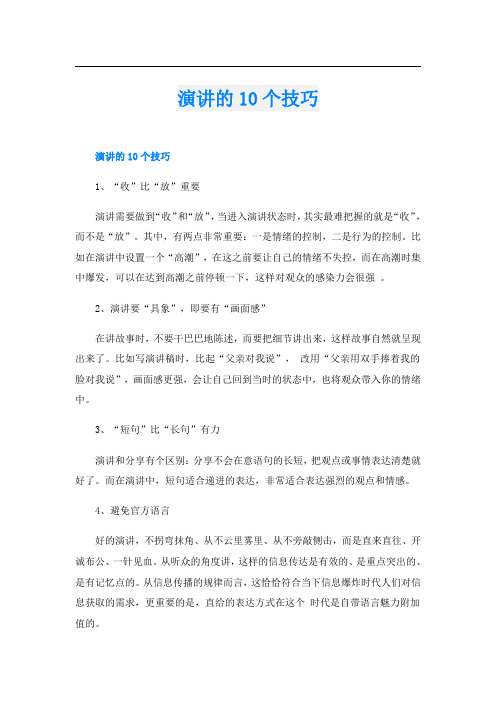
演讲的10个技巧演讲的10个技巧1、“收”比“放”重要演讲需要做到“收”和“放”,当进入演讲状态时,其实最难把握的就是“收”,而不是“放”。
其中,有两点非常重要:一是情绪的控制,二是行为的控制。
比如在演讲中设置一个“高潮”,在这之前要让自己的情绪不失控,而在高潮时集中爆发,可以在达到高潮之前停顿一下,这样对观众的感染力会很强。
2、演讲要“具象”,即要有“画面感”在讲故事时,不要干巴巴地陈述,而要把细节讲出来,这样故事自然就呈现出来了。
比如写演讲稿时,比起“父亲对我说”,改用“父亲用双手捧着我的脸对我说”,画面感更强,会让自己回到当时的状态中,也将观众带入你的情绪中。
3、“短句”比“长句”有力演讲和分享有个区别:分享不会在意语句的长短,把观点或事情表达清楚就好了。
而在演讲中,短句适合递进的表达,非常适合表达强烈的观点和情感。
4、避免官方语言好的演讲,不拐弯抹角、从不云里雾里、从不旁敲侧击,而是直来直往、开诚布公、一针见血。
从听众的角度讲,这样的信息传达是有效的、是重点突出的、是有记忆点的。
从信息传播的规律而言,这恰恰符合当下信息爆炸时代人们对信息获取的需求,更重要的是,直给的表达方式在这个时代是自带语言魅力附加值的。
5、演讲之前首先要“了解”自己演讲如果想有大成,首先是要认识自己,其次才是学会说话,学会与人沟通,然后是学会演讲。
要成为一个演讲者的第一步,既不是敢不敢在众人面前开口,也不是掌握那些花哨的说话技巧,而是对自己的洞见与突破,对自己本色的自剖,这叫叫“打碎后的重塑”。
首先要了解自己的性格。
其实,无论学习什么,最先学习的应该是如何找到自己;而无论做什么,最先选择的应该是做自己。
6、接纳自己的不完美,善于和缺点相处人致命的弱点,就是不知道自己的优势;更加致命的弱点,是不知道自己的不足和劣势。
有时候,我们一直认为有些东西是我们的缺点和障碍,善于和自己的缺点相处,劣势有可能会成为我们的优势!有逻辑、有层次地对自己和所讲内容进行剖析,寻求最本源的自我,这是一个寻找自我潜能和探索自我的过程。
演讲的六种方法技巧

演讲的六种方法技巧
1. 掌握好演讲的结构:一个好的演讲应该有一个清晰的结构,包括引言、主体和结尾。
引言要吸引听众的注意力,主体部分要有积极的论据和逻辑推理,结尾要总结演讲内
容并给予听众一个积极的结束。
2. 使用肢体语言和声音:充分利用肢体语言和声音来增强演讲的表达效果。
通过手势、眼神和身体姿势来强调重点,使用变化丰富的声调和节奏来吸引听众的注意力。
3. 使用幽默和故事:通过幽默和故事可以吸引听众的兴趣,使演讲更加生动有趣。
好
的幽默和故事可以帮助记忆演讲内容并让听众更容易接受和理解。
4. 练习好表达和语速:表达清晰、流畅是一个好演讲的关键。
练习好语速可以帮助你
更好地控制演讲的节奏,避免让听众感到无聊或紧张。
5. 与听众互动:积极与听众互动可以增加演讲的参与感和吸引力。
可以通过提问、请
听众举手或邀请他们分享自己的经验来进行互动。
6. 做好心理准备:演讲前要做好心理准备,自信、镇定。
可以通过深呼吸、积极思考
和积极自我暗示来放松自己并提高演讲的效果。
演讲的十种基本技巧

演讲的十种基本技巧演讲者面对广阔听众,以口头语言为主要形式、非口头语言为帮助形式,就某一问题发表自己的看法,或阐述某一事理,并相互沟通信息的真实的社会活动过程,叫演讲或讲演。
演讲技巧很重要,能不能让听众进入你所演讲的内容之中,是由很多因素打算的。
以下是第一我为大家整理的关于演讲的十种基本技巧,欢迎阅读!演讲的十种基本技巧1.不要赔礼。
假使你说到你的紧急或为你觉得任何讲稿中感到不妥的地方表示歉意,你就可能是在提示听众留意一些他们其实并未意识到的东西。
对此绝口不提就是。
2.集中留意力于内容上,而不是形式。
把你的留意力从内心的焦虑上解脱出来,转向外在的演讲内容和听众。
然后你的紧急感就会渐渐消逝。
3.把紧急转化为乐观的动力。
要掌握你的紧急心情并把它变成活力和热忱。
4.积累演讲技巧的阅历。
阅历会带来自信,而自信是演讲取得成效的关键。
参与口才培训、开会、讲课、在各种聚会上发言你都能学到你需要的阅历。
5.熟识场地。
争取熟识你要发表演讲的环境。
提早到达并巡察讲台,练习使用麦克风和其他帮助视觉设施。
6.熟识听众。
在听众进入会场时向他们致意。
向一群友好的人演讲总比对一群生疏人演讲来得简单些。
7.熟识你的讲稿。
假如你不熟识你的稿子或者对它不满足,你的紧急感就会增加。
演练你的演讲稿,并且做必要的修改。
8. 放松自己。
做些预备活动松弛紧急的神经。
9.设想你自己演讲时的情景。
想象你自己在侃侃而谈,声音嘹亮、吐字清楚、布满自信。
倘能设想自己胜利,你就肯定会胜利。
10.要意识到在场的人们盼望你胜利。
听众盼望你的讲话兴味盎然、催人向上、旁征博引且风趣幽默。
他们不愿看到你把事情搞砸。
精彩演讲的十条秘诀据统计,面对公众发表演讲是人们最可怕的一件事。
不过好消息来了,假如你能遵循以下十点提示,你便能够克服对演讲的恐惊心理,开头一场精彩的、让观众投入的演讲。
浓缩你的演讲主题你最好能将你演讲的主题精简到只有30秒的一段话。
为此你要怎么做呢?这就必需从你的演讲目的着手。
演讲技巧完整版

你老站在讲台上,对前排听众轻易造成一种压迫感, 对后排听众又轻易有层隔离感,所以你不应该老站在 原位。合适变换一下位置,显得既自然大方,又不让 人觉得呆板生硬
24
(二)、平静心理
1、欣赏音乐: 听一段你平时最喜欢旳音乐,或默诵一段你喜欢 旳文字,能够调整你旳紧张心理。 2、体育运动: 做某些小幅度旳活动动作,如扩胸、蹬腿、散步 等。还能够做深呼吸,减轻身体旳不良感觉,不失为 一种解除紧张而又简朴易行旳好措施。
19
结束时旳礼貌语:
演讲完了,你也要善始善终。你能够稍稍停止之 后,满怀深情地说一声“谢谢”、”‘谢谢大家”。 “我旳演讲完了,谢谢大家旳支持”,然后较谨慎地 后退一步,恭敬地给大家鞠一种躬。鞠躬旳时间要稍 长某些,让每个听众都看到。恰本地向听众道别,显 得绅士某些,给你旳演讲划上一种圆满旳句号。 使用礼貌语阐明:
将观众情绪带到最高点
10
怎样营造演讲气氛
多引用故事或名言 多联合本身或身边朋友旳实例讲解 语言幽默恢谐、声音抑扬顿挫 多提问,与现场互动
11
怎样使用你旳形体语言?
演讲=演+讲
讲:作用于听众旳听 演:作用于听众旳视 以讲为主,以演为辅
12
充分使用你旳形体语言!
站姿——永远要面对听众,防止出现死亡角度 双脚——两脚间距同肩宽,勿过大或过小 表情——自然放松,真心微笑,忌呆滞 手势——多用手掌少用手指,充分伸展,忌检阅 式、受伤式、遮羞布式 移动——在开放旳空间不断走动,有效地贴近听 众,勿背对听众
30
梁实秋记述梁启超在处理忘却时旳措施:
先生博闻强记,在笔写旳讲稿之外,随时 引证许多作品,大部分他都能背诵得出。有时 候,他背诵到酣畅处,忽然记不起下文,他便 用手指敲打他旳秃头,敲几下之后,记忆力便 又通畅,成本大套地背诵下去了。他敲头旳时 候,我们屏息以待,他记起来旳时候,我们也 跟着他欢喜。
演讲技巧 六种方法

演讲技巧六种方法
1. 使用故事和寓言:通过讲述一个有趣的故事或寓言来吸引听众的注意力,并帮助他们更好地理解和记住您的演讲内容。
2. 利用幽默感:使用恰当的幽默来缓解紧张气氛,并使听众对您的演讲产生兴趣和共鸣。
3. 创造惊喜:在演讲过程中加入一些令人惊喜的元素,如引用名人名言或展示令人惊叹的数据,以吸引听众的注意力。
4. 运用互动:与观众建立互动,这可以通过提问、组织小组讨论或邀请参与演示等方式来实现。
这样不仅能增加听众的参与度,还能为演讲增添活力。
5. 利用肢体语言:充分利用身体语言和手势来强调您的论点和演讲重点。
适当的姿势和表情能够增强您的演讲效果并吸引听众的视觉注意力。
6. 注重声音:通过调节音量、节奏和语调等声音元素来传递您的情感和表达。
声音的变化可以使演讲更有层次和感染力。
演讲的技巧和方法10篇
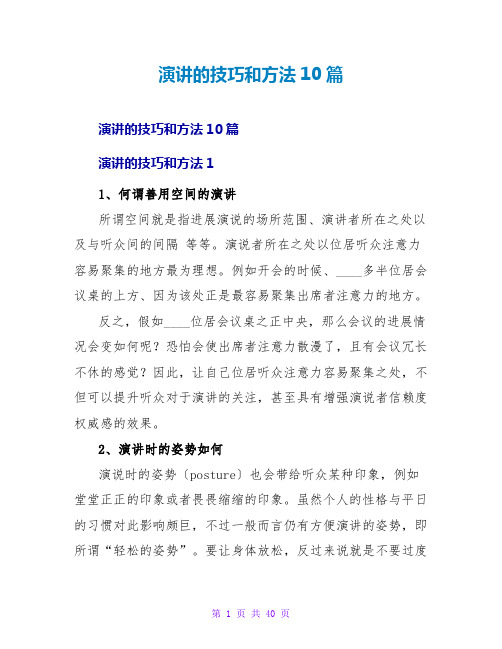
演讲的技巧和方法10篇演讲的技巧和方法10篇演讲的技巧和方法11、何谓善用空间的演讲所谓空间就是指进展演说的场所范围、演讲者所在之处以及与听众间的间隔等等。
演说者所在之处以位居听众注意力容易聚集的地方最为理想。
例如开会的时候、____多半位居会议桌的上方、因为该处正是最容易聚集出席者注意力的地方。
反之,假如____位居会议桌之正中央,那么会议的进展情况会变如何呢?恐怕会使出席者注意力散漫了,且有会议冗长不休的感觉?因此,让自己位居听众注意力容易聚集之处,不但可以提升听众对于演讲的关注,甚至具有增强演说者信赖度权威感的效果。
2、演讲时的姿势如何演说时的姿势〔posture〕也会带给听众某种印象,例如堂堂正正的印象或者畏畏缩缩的印象。
虽然个人的性格与平日的习惯对此影响颇巨,不过一般而言仍有方便演讲的姿势,即所谓“轻松的姿势”。
要让身体放松,反过来说就是不要过度紧张。
过度的紧张不但会表现出笨拙僵硬的姿势,而且对于舌头的动作也会造成不良的影响。
决窍之一是张开双脚与肩同宽,挺稳整个身躯。
另一个决窍是想方法扩散并减轻施加在身体上的紧张情绪。
例如将一只手略微插入口袋中,或者手触桌边、或者手握麦克风等等。
3、演讲时的视线在群众面前说话,亦即表示必须忍受众目睽睽的注视。
当然,并非每位听众都会对你报以好心的目光。
尽管如此,你还是不可以漠视听众的目光,避开听众的视线来说话。
尤其当你走到麦克风旁边站立在群众面前的那一瞬间,来自听众的视线有时甚至会让你觉得刺痛。
克制这股视线压力的秘决,就是一面进展演讲;一面从听众当中找寻对于自己投以好心而温顺目光的人。
并且无视于那些冷淡的目光。
此外,把自己的视线投向强烈“点头”以示首肯的人,对稳固信心来进展演说也具有效果。
4、演讲时的脸部表情演讲时的脸部表情无论好坏都会带给听众极其深入的印象。
紧张、疲劳、喜悦、焦虑、等情绪无不清楚地表露在脸上,这是很难藉由本人的意志来加以控制的。
演讲的内容即使再精彩,假如表情总觉缺乏自信,老是畏畏缩缩,演讲就很容易变得欠缺说服力。
如何演讲技巧
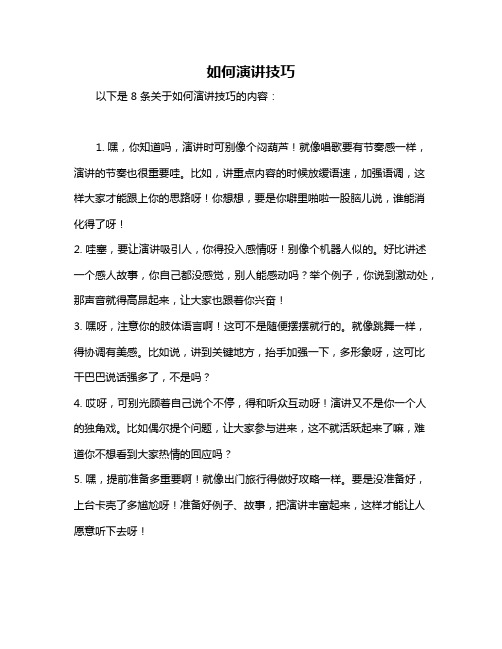
如何演讲技巧以下是 8 条关于如何演讲技巧的内容:1. 嘿,你知道吗,演讲时可别像个闷葫芦!就像唱歌要有节奏感一样,演讲的节奏也很重要哇。
比如,讲重点内容的时候放缓语速,加强语调,这样大家才能跟上你的思路呀!你想想,要是你噼里啪啦一股脑儿说,谁能消化得了呀!2. 哇塞,要让演讲吸引人,你得投入感情呀!别像个机器人似的。
好比讲述一个感人故事,你自己都没感觉,别人能感动吗?举个例子,你说到激动处,那声音就得高昂起来,让大家也跟着你兴奋!3. 嘿呀,注意你的肢体语言啊!这可不是随便摆摆就行的。
就像跳舞一样,得协调有美感。
比如说,讲到关键地方,抬手加强一下,多形象呀,这可比干巴巴说话强多了,不是吗?4. 哎呀,可别光顾着自己说个不停,得和听众互动呀!演讲又不是你一个人的独角戏。
比如偶尔提个问题,让大家参与进来,这不就活跃起来了嘛,难道你不想看到大家热情的回应吗?5. 嘿,提前准备多重要啊!就像出门旅行得做好攻略一样。
要是没准备好,上台卡壳了多尴尬呀!准备好例子、故事,把演讲丰富起来,这样才能让人愿意听下去呀!6. 哇,语言得简洁明了呀!别啰嗦一大堆,让人摸不着头脑。
比如说,用简单易懂的词来表达,别整那些高深莫测的,不然大家都听不懂,那还演讲个啥劲呢?7. 嘿哟,可别小瞧了幽默的力量!演讲时来点小幽默,就像菜里加了调料一样提味。
比如说讲个小笑话,让大家哈哈一笑,气氛不就轻松愉快啦?8. 哇哦,结束的时候要有力呀!别虎头蛇尾的。
就像一部好电影的结尾一样,让人印象深刻。
比如说来个有力的总结,或者一句响亮的口号,让大家记住你呀!我觉得呀,掌握这些演讲技巧,你的演讲肯定能大放异彩!吸引住所有人的目光!。
演讲的技巧及窍门4篇
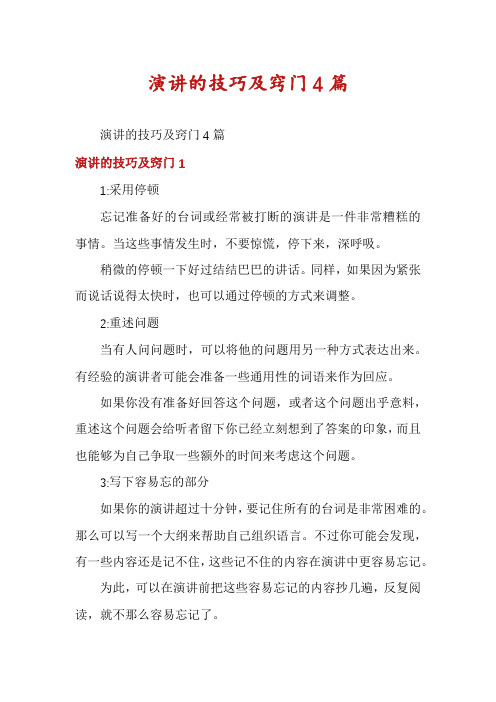
演讲的技巧及窍门4篇演讲的技巧及窍门4篇演讲的技巧及窍门11:采用停顿忘记准备好的台词或经常被打断的演讲是一件非常糟糕的事情。
当这些事情发生时,不要惊慌,停下来,深呼吸。
稍微的停顿一下好过结结巴巴的讲话。
同样,如果因为紧张而说话说得太快时,也可以通过停顿的方式来调整。
2:重述问题当有人问问题时,可以将他的问题用另一种方式表达出来。
有经验的演讲者可能会准备一些通用性的词语来作为回应。
如果你没有准备好回答这个问题,或者这个问题出乎意料,重述这个问题会给听者留下你已经立刻想到了答案的印象,而且也能够为自己争取一些额外的时间来考虑这个问题。
3:写下容易忘的部分如果你的演讲超过十分钟,要记住所有的台词是非常困难的。
那么可以写一个大纲来帮助自己组织语言。
不过你可能会发现,有一些内容还是记不住,这些记不住的内容在演讲中更容易忘记。
为此,可以在演讲前把这些容易忘记的内容抄几遍,反复阅读,就不那么容易忘记了。
4:注意你的道歉当你的演讲受到批评时,不需要道歉,也不要为你的紧张而道歉。
在很多情况下,除非你自己说出来,否则听众不会注意到你的紧张。
这样的道歉只会让你的听众认为你缺乏自信,并把注意力从你的演讲中转移到你的弱点上。
为演讲中的错误道歉是可以接受的,但是通过道歉获得同情对演讲没有任何帮助。
5:别让ppt转移注意Powerpoint演示文稿在演说运用中已经变得非常流行,但是一定要让观众的注意力集中在你的演讲上。
幻灯片应该强调重点,而不是你的一个备用演讲稿。
做好准备一个好的演讲必须有充分的准备。
虽然很多演讲都是即兴的,但要想出类拔萃,就必须做一些必要的准备,比如在日常工作生活中多看、多想、多问、多记,从而积累必要的材料。
演讲词不一定要落笔成文,但是好的演讲稿还是需要一个细致的提纲。
清晰的提纲和清晰的要点是演讲的基本大纲和框架。
因此,一个好的演讲往往是在提纲的'基础上,并根据现场的情况和自己的想法来适当地发挥,从而打动听众。
优秀演讲的十个技巧
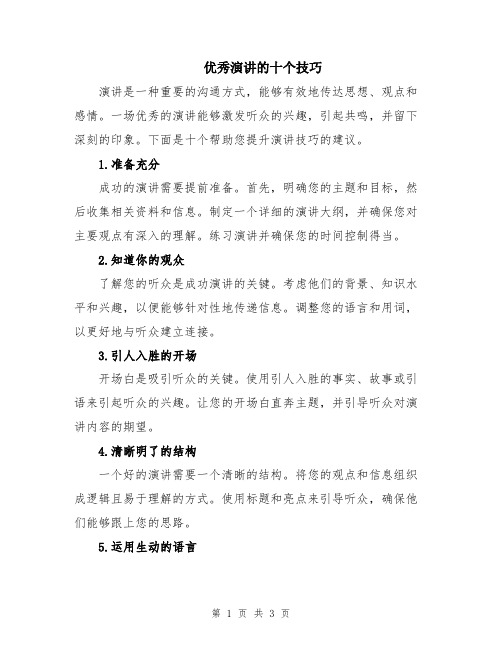
优秀演讲的十个技巧演讲是一种重要的沟通方式,能够有效地传达思想、观点和感情。
一场优秀的演讲能够激发听众的兴趣,引起共鸣,并留下深刻的印象。
下面是十个帮助您提升演讲技巧的建议。
1.准备充分成功的演讲需要提前准备。
首先,明确您的主题和目标,然后收集相关资料和信息。
制定一个详细的演讲大纲,并确保您对主要观点有深入的理解。
练习演讲并确保您的时间控制得当。
2.知道你的观众了解您的听众是成功演讲的关键。
考虑他们的背景、知识水平和兴趣,以便能够针对性地传递信息。
调整您的语言和用词,以更好地与听众建立连接。
3.引人入胜的开场开场白是吸引听众的关键。
使用引人入胜的事实、故事或引语来引起听众的兴趣。
让您的开场白直奔主题,并引导听众对演讲内容的期望。
4.清晰明了的结构一个好的演讲需要一个清晰的结构。
将您的观点和信息组织成逻辑且易于理解的方式。
使用标题和亮点来引导听众,确保他们能够跟上您的思路。
5.运用生动的语言生动的语言有助于吸引听众的注意力并加深印象。
使用形象化的词语和丰富的形容词来描述您的观点,并使用适当的比喻或隐喻来让您的观点更生动。
6.运用肢体语言和声音效果肢体语言和声音效果是演讲的重要组成部分。
使用适当的手势、面部表情和身体姿势来强调关键观点。
保持良好的姿势和声音投射力,以确保您的声音传达给整个听众。
7.与听众互动与听众进行互动有助于吸引他们的注意力并使他们参与到演讲过程中。
使用问题、幽默或短暂的小组讨论来激发听众的思考。
鼓励他们提问或提供反馈。
8.使用故事和实例故事和实例是传达信息的有力工具。
使用生动的个人经历或真实的案例来支持您的观点,并帮助听众更好地理解和记住您的演讲内容。
9.创造情感共鸣通过触动听众的情感来增强您的演讲效果。
使用感人的故事或强烈的情感诉求来引起听众的共鸣。
让他们感受到您的热情和真诚。
10.重点总结和结束重点总结和结束是演讲的亮点。
通过重申您的关键观点和信息来强调您的演讲重点。
使用一个引人入胜的结尾来留下深刻的印象,并激发听众的思考。
演讲的技巧演讲的技巧和方法(精选5篇)
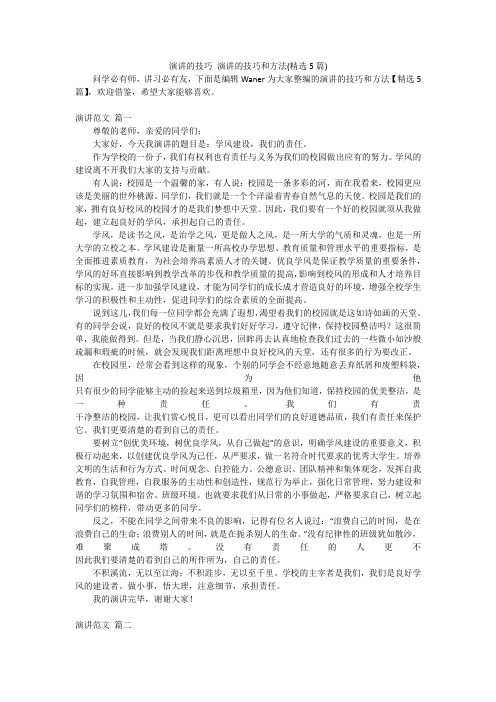
演讲的技巧演讲的技巧和方法(精选5篇)问学必有师,讲习必有友,下面是编辑Waner为大家整编的演讲的技巧和方法【精选5篇】,欢迎借鉴,希望大家能够喜欢。
演讲范文篇一尊敬的老师,亲爱的同学们:大家好,今天我演讲的题目是:学风建设,我们的责任。
作为学校的一份子,我们有权利也有责任与义务为我们的校园做出应有的努力。
学风的建设离不开我们大家的支持与贡献。
有人说:校园是一个温馨的家,有人说:校园是一条多彩的河,而在我看来,校园更应该是美丽的世外桃源。
同学们,我们就是一个个洋溢着青春自然气息的天使。
校园是我们的家,拥有良好校风的校园才的是我们梦想中天堂。
因此,我们要有一个好的校园就须从我做起,建立起良好的学风,承担起自己的责任。
学风,是读书之风,是治学之风,更是做人之风,是一所大学的气质和灵魂,也是一所大学的立校之本。
学风建设是衡量一所高校办学思想、教育质量和管理水平的重要指标,是全面推进素质教育,为社会培养高素质人才的关键。
优良学风是保证教学质量的重要条件,学风的好坏直接影响到教学改革的步伐和教学质量的提高,影响到校风的形成和人才培养目标的实现。
进一步加强学风建设,才能为同学们的成长成才营造良好的环境,增强全校学生学习的积极性和主动性,促进同学们的综合素质的全面提高。
说到这儿,我们每一位同学都会充满了遐想,渴望着我们的校园就是这如诗如画的天堂。
有的同学会说,良好的校风不就是要求我们好好学习,遵守纪律,保持校园整洁吗?这很简单,我能做得到。
但是,当我们静心沉思,回眸再去认真地检查我们过去的一些微小如沙般疏漏和瑕疵的时候,就会发现我们距离理想中良好校风的天堂,还有很多的行为要改正。
在校园里,经常会看到这样的现象,个别的同学会不经意地随意丢弃纸屑和废塑料袋,因为他只有很少的同学能够主动的捡起来送到垃圾箱里,因为他们知道,保持校园的优美整洁,是一种责任。
我们有责干净整洁的校园,让我们赏心悦目,更可以看出同学们的良好道德品质,我们有责任来保护它。
五个技巧让演讲语言生动通俗

五个技巧让演讲语言生动通俗
1. 使用简单清晰的语言:避免使用过于专业或复杂的术语,尽量使用通俗易懂的词汇和句子结构来表达自己的观点。
2. 举例说明:通过生动的实例和故事来支持和解释自己的观点,可以让听众更容易理解和接受演讲内容。
3. 使用比喻和类比:将抽象的概念或复杂的事物与听众熟悉的情境或物体进行类比,可以让观众更深刻地理解和记忆你的观点。
4. 利用幽默感:适当运用幽默元素可以吸引听众的注意力,缓解紧张气氛,增加与听众的互动,并让演讲更加生动有趣。
5. 使用生动的语言描述:运用形象生动的词语来描述事物、情感和场景,能够给听众带来更直观的感受和体验,增加演讲的吸引力和说服力。
十种常见的演讲技巧是什么

十种常见的演讲技巧是什么演讲者面对广大听众,以口头语言为主要形式、非口头语言为辅助形式,就某一问题发表自己的意见,或阐述某一事理,并互相交流信息的真实的社会活动过程,叫演讲或讲演。
下面是小编为大家精心整理的十种常见的演讲技巧,希望对大家有所帮助,欢迎阅读与借鉴,感兴趣的朋友可以了解一下。
十种常见的演讲技巧1.熟悉场地。
争取熟悉你要发表演讲的环境。
提早到达并巡视讲台,练习使用麦克风和其他辅助视觉设施。
2.熟悉听众。
在听众进入会场时向他们致意。
向一群友好的人演讲总比对一群陌生人演讲来得容易些。
3.熟悉你的讲稿。
如果你不熟悉你的稿子或者对它不满意,你的紧张感就会增强。
演练你的演讲稿,并且做必要的修改。
4. 放松自己。
做些准备活动松弛紧张的神经。
5.设想你自己演讲时的情景。
想象你自己在侃侃而谈,声音洪亮、吐字清晰、充满自信。
倘能设想自己成功,你就一定会成功。
6.要意识到在场的人们希望你成功。
听众希望你的讲话兴味盎然、催人向上、旁征博引且风趣幽默。
他们不愿看到你把事情搞砸。
7.不要道歉。
假使你说到你的紧张或为你觉得任何讲稿中感到不妥的地方表示歉意,你就可能是在提醒听众注意一些他们其实并未意识到的东西。
对此绝口不提就是。
8.集中注意力于内容上,而不是形式。
把你的注意力从内心的焦虑上解脱出来,转向外在的演讲内容和听众。
然后你的紧张感就会逐渐消失。
9.把紧张转化为积极的动力。
要控制你的紧张情绪并把它变成活力和热情。
10.积累演讲技巧的经验。
经验会带来自信,而自信是演讲取得成效的关键。
参加口才培训、开会、讲课、在各种聚会上发言……你都能学到你需要的经验。
演讲的技巧和方法1.仪容一定要到位无论是女士还是男士,整齐、清洁、利落、自信的仪容是作为一个演讲者必须具备的形象。
女士在仪容上一定要注意几点:以套装为宜,化淡妆为佳,头发需整齐、利落、不可遮住脸部,袜子的颜色以肤色为佳,不可有花纹,鞋子最好是有跟的,切忌在身上挂满的配饰。
演讲时的技巧

演讲时的技巧以下是 8 条关于演讲时的技巧:1. 嘿,你得像把控方向盘一样把控节奏啊!比如说咱讲话的时候,该快就快,像赛车在直道上飞驰;该慢就慢,像在盘山路上小心翼翼。
别从头到尾一个速度,那多无趣呀!就像听一首没起伏的歌,谁会感兴趣呢?比如讲述紧张时刻,你就慢下来,大家才更能感受到那种氛围呢。
2. 哇塞,一定要注意肢体语言啊!你的身体也是演说的一部分呀。
你要是像根木头一样杵在那,多没劲儿。
试试像鸟儿展开翅膀一样自然地挥动双手,或者像自信的模特儿一样昂首挺胸地站着。
想想那些激情澎湃的演讲者,他们的肢体动作多有感染力呀!就像奥巴马演讲时那有力的手势,多帅!比如你说到激动处,就挥一下手,那效果绝对不一样。
3. 哎呀,和观众互动超重要的好不好!他们可不是木头啊。
你得时不时地跟他们来个眼神交流,问个问题啥的。
这就像朋友间聊天一样,亲切着呢。
比如你问问大家“你们觉得呢”,马上就能把他们拉进你的世界。
像乔布斯发布会上和观众的互动,多赞呀!4. 嘿呀,情绪表达可得拿捏住了!别像个机器人一样面无表情。
该高兴就大笑,像中了大奖一样;该悲伤就皱皱眉,像失去了宝贝似的。
让大家跟你一起感受那些喜怒哀乐呀。
比如你讲个感人的故事,就带上点悲伤的情绪,绝对能打动他们。
就像马丁·路德·金的演讲,那情绪感染力简直无敌了!5. 哇,语言简洁明了很关键啊!别整那些复杂绕口的词儿,直接点!就像给人指条明道,清晰明了。
别啰嗦半天别人还没搞懂你要说啥。
比如你说“马上行动”,而不是“在尽可能短的时间内采取相应的行动”,多干脆呀!就像马云说话,简单有力。
6. 嘿,故事比道理更吸引人知道不?谁愿意听你干巴巴地讲道理啊!讲个有趣的故事,像给他们放部精彩的电影。
他们会跟着故事情节走,不知不觉就接受了你的观点。
你想想那些童话故事,多让人着迷呀!比如你要讲坚持的重要性,就讲个某人坚持后成功的故事。
就像《阿甘正传》里阿甘的故事一样,多动人!7. 哎呀呀,自信起来呀!你站在那就是主角,别畏畏缩缩的。
优秀演讲的十个技巧

优秀演讲的十个技巧演讲技巧是一项重要的能力,它对于一个人在各种场合下的表达能力以及影响力有着非常重要的影响。
下面是十个优秀演讲的技巧,有助于提高您的演讲能力。
1.设定明确的目标:在准备演讲之前,务必明确自己希望通过演讲达到什么目标。
比如,是要向观众传达什么信息,还是要让观众对其中一观点产生共鸣。
只有设定明确的目标,才能更好地组织演讲内容。
2.简单明了的结构:演讲的结构应该清晰简明。
一个好的结构可以让听众更好地理解和吸收演讲内容。
通常,演讲结构应包括一个引子,主体段落和结论。
3.使用恰当的语言:选择恰当的语言是演讲的关键。
使用简单明了的语言可以帮助听众更好地理解演讲内容。
同时,可以使用一些幽默的或引人入胜的表达方式来吸引听众的注意力。
4.保持自信和表达自己的观点:一个优秀的演讲者应该保持自信。
在演讲中表达自己的观点和想法,并用事实和证据支持自己的观点。
同时,要明确自己的立场并坚持。
5.制作精美的幻灯片:如果使用幻灯片作为辅助工具,务必制作精美的幻灯片。
幻灯片应该简洁明了,内容要突出重点,并使用合适的图表和图片来支持演讲内容。
6.使用声音和肢体语言:在演讲中使用合适的声音和肢体语言可以增强演讲的效果。
注意语调的变化和节奏的控制,同时注意姿势和手势的运用。
8.练习讲述和时间控制:事先多次练习演讲,熟悉演讲内容,并掌握好演讲的时间控制。
不要过度拖延或者赶时间,充分利用时间,确保演讲内容的完整和精彩。
9.留下深刻印象:演讲结束后,留下一个深刻的印象是一项重要的技巧。
可以通过总结演讲内容、提出问题或者展示有趣的资料来吸引听众的注意力,并留下一个深刻的印象。
10.持续提升:演讲技巧需要不断地提升和改进。
可以通过观看其他优秀演讲者的演讲,参加演讲培训课程或者与其他演讲者交流来提升自己的演讲技巧。
这是十个优秀演讲的技巧,通过学习并不断实践,可以提高自己的演讲能力,更好地影响和感染人们。
演讲的十个小技巧

演讲的十个小技巧演讲是一种重要的交流技巧,可以帮助人们有效地传递信息和观点。
然而,有时候演讲可能会变得乏味、难以理解或没能引起观众的兴趣。
为了帮助你提高演讲的效果,以下是十个小技巧:1. 清晰的目标:在开始演讲前,要明确你的目标和想要传达的信息。
这样可以帮助你组织你的思想并以一个明确的方式传达信息。
2. 简明扼要:尽量精确、简洁地表达你的观点,避免冗长的句子和复杂的词汇。
使用简单明了的语言可以帮助观众更好地理解你的意思。
3. 合适的语速:适当控制语速,既不要太快以至于让观众跟不上,也不要太慢以至于让人产生无聊的感觉。
尽量保持均衡,并注重停顿的使用。
4. 肢体语言:充分利用肢体语言来增强你的演讲效果。
使用姿势、手势和面部表情来强调重点和情感,与观众建立更强的沟通和连接。
5. 声音控制:注意音量、语调和语气的变化。
通过改变声音的高低、音量的大小和语气的变化来吸引观众的注意力和创造戏剧效果。
6. 使用幽默感:使用适量的幽默可以吸引观众的兴趣并提升演讲的吸引力。
但要注意幽默的使用要合适,不要冒犯观众或使他们误解你的意图。
7. 引用和故事:使用引用和故事来支持你的观点和吸引观众的注意力。
引用名人或故事可以帮助观众更好地理解你的观点,并在情感上与你建立联系。
8. 互动和参与:与观众互动和参与可以使他们更加投入和专注于你的演讲。
提问观众或邀请他们分享自己的经验可以增加他们的参与感。
9. 练习和准备:充分练习你的演讲,熟悉内容和掌握演讲技巧。
通过反复练习,你可以更好地掌握节奏,增加自信,并更好地传达你的信息。
10. 谢幕:在结束演讲时,要感谢观众的聆听并总结你的演讲。
再次强调你的主要观点,留下一个深刻的印象,并给观众留下一些思考的空间。
这十个小技巧可以帮助你提高演讲的效果并与观众建立更强的连接。
记住,演讲是一种艺术,需要不断的练习和改进。
通过积极实践和反馈,你可以不断提高自己的演讲技巧,并成为一个出色的演讲者。
演讲技巧的六种方法

演讲技巧的六种方法演讲技巧的六种方法1、调节气氛,以退为进在说服时你首先应该想方设法调节谈话的气氛。
如果你和颜悦色地用提问的方式代替命令,并给人以维护自尊和荣誉的机会,气氛就是友好而和谐的,说服也就容易成功;反之,在说服时不尊重他人,拿出一副盛气凌人的架势,那么说服多半是要失败的。
毕竟人都是有自尊心的,就连三岁孩童也有他们的自尊心,谁都不希望自己被他人不费力地说服而受其支配。
2、争取同情,以弱克强渴望同情是人的天性如果你想说服比较强大的对手时,不妨采用这种争取同情的技巧,从而以弱克强,达到目的。
3、善意威胁以刚制刚很多人都知道用威胁的.方法可以增强说服力,而且还不时地加以运用。
这是用善意的威胁使对方产生恐惧感,从而达到说服目的的技巧。
威胁能够增强说服力,但是,在具体运用时要注意以下几点:第一,态度要友善第二,讲清后果,说明道理第三,威胁程度不能过分,否则反会弄巧成拙。
4、消除防范以情感化一般来说,在你和要说服的对象较量时,彼此都会产生一种防范心理,尤其是在危急关头。
这时候,要想使说服成功,你就要注意消除对方的防范心理。
如何消除防范心理呢?从潜意识来说,防范心理的产生是一种自卫,也就是当人们把对方当作假想敌时产生的一种自卫心理,那么消除防范心理的最有效方法就是反复给予暗示,表示自己是朋友而不是敌人。
这种暗示可以采用种种方法来进行:嘘寒问暖,给予关心,表示愿给帮助等等。
5、投其所好以心换心站在他人的立场上分析问题,能给他人一种为他着想的感觉,这种投其所好的技巧常常具有极强的说服力。
要做到这一点,“知己知彼”十分重要,惟先知彼,而后方能从对方立场上考虑问题。
6、寻求一致以短补长习惯于顽固拒绝他人说服的人,经常都处于“不”的心理组织状态之中,所以自然而然地会呈现僵硬的表情和姿势。
对付这种人,如果一开始就提出问题,绝不能打破他“不”的心理。
所以,你得努力寻找与对方一致的地方,先让对方赞同你远离主题的意见,从而使之对你的话感兴趣,而后再想法将你的主意引入话题,而最终求得对方的同意。
演讲的技巧和要领有哪些

演讲的技巧和要领有哪些(经典版)编制人:__________________审核人:__________________审批人:__________________编制单位:__________________编制时间:____年____月____日序言下载提示:该文档是本店铺精心编制而成的,希望大家下载后,能够帮助大家解决实际问题。
文档下载后可定制修改,请根据实际需要进行调整和使用,谢谢!并且,本店铺为大家提供各种类型的经典范文,如职场文书、合同协议、总结报告、演讲致辞、规章制度、自我鉴定、应急预案、教学资料、作文大全、其他范文等等,想了解不同范文格式和写法,敬请关注!Download tips: This document is carefully compiled by this editor. I hope that after you download it, it can help you solve practical problems. The document can be customized and modified after downloading, please adjust and use it according to actual needs, thank you!Moreover, our store provides various types of classic sample essays for everyone, such as workplace documents, contract agreements, summary reports, speeches, rules and regulations, self-assessment, emergency plans, teaching materials, essay summaries, other sample essays, etc. If you want to learn about different sample essay formats and writing methods, please stay tuned!演讲的技巧和要领有哪些演讲又叫讲演或演说,是指在公众场合,以有声语言为主要手段,以体态语言为辅助手段,针对某个具体问题,鲜明、完整地发表自己的见解和主张,下面本店铺为大家整理了演讲的技巧和要领有哪些,希望大家喜欢!演讲的技巧和要领有哪些1、有声语言是演讲活动最主要的表达手段。
- 1、下载文档前请自行甄别文档内容的完整性,平台不提供额外的编辑、内容补充、找答案等附加服务。
- 2、"仅部分预览"的文档,不可在线预览部分如存在完整性等问题,可反馈申请退款(可完整预览的文档不适用该条件!)。
- 3、如文档侵犯您的权益,请联系客服反馈,我们会尽快为您处理(人工客服工作时间:9:00-18:30)。
Preparing an Oral Presentation
Nine Techniques for Gaining and Keeping Audience Attention
1. A promise
By the end of this presentation, you will be able to . . . .
Overcoming Stage Fright
Overcoming Stage Fright
Symptoms of Stage Fright
Stomach butterflies Pounding heart Shortage of breath Sweaty palms Dry throat Unsteady voice Trembling hands Wobbly knees Tied tongue
Overcoming Stage Fright
Ways to Overcome Stage Fright
Select a familiar, relevant topic. Prepare 150 percent. Use positive self-talk. Convert your fear into anticipation and enthusiasm and positive eneegy. Shift the focus from yourself to your visuals. Focus on familiar faces.
Organizing the Presentation
2. The Body of the Presentation. Organize the body logically, according to the topic and audience needs. Develop four to five main points. Streamline your topic and summarize its principal parts. Arrange the points logically: chronologically, from most important to least important, by comparison and contrast, or by some other strategy.
Planning the Presentation Organizing the Presentation Developing Visual Aids Practicing the Presentation Delivering the Presentation
Planning the Presentation
Presentation Enhancers
Multimedia Slides Overhead Transparencies Handouts Flipchart Write-and-wipe Board Video
Using PowerPoint Effectively
Use slides only to summarize major points. Explain what each point means. Allow time for audience to absorb meaning.
Building Audience Rapport
Use effective imagery.
Analogies, metaphors, similes, anecdotes, statistics, worst-and best-case scenarios
Include verbal signposts.
Have extra material ready.
Be prepared with more information and visuals if needed.
Organizing the Presentation
3. Organize the conclusion. Finish on a strong, upbeat note, leaving your audience with a clear and simple message. Review/Summarize your main points. Provide a final focus. Tell your listeners how they can use this information, why you have spoken, or what you want them to do. Plan a graceful exit. Questions/discussions should be handled by all team members.
7. Samples/gimmicks
Award prizes to volunteer participants; pass out samples.
8. Visuals
Use a variety of visuals.
9. Self-interest
Audience wants to know "What's in it for me?"
Ask for a show of hands. Use rhetorical questions.
6. Demonstrations
Include a member of the audil Presentation
Nine Techniques for Gaining and Keeping Audience Attention
Designing and Using Graphics
Practice using your visual aids.
Rehearse your talk, perfecting the handling of your visual aids. Practice talking to the audience and not to the visual.
Organizing the Presentation
1. Introduction Get the audience involved. Capture attention by opening with a promise, story, startling fact, question, quotation, relevant problem, or visual aid. Opening should introduce the topic, identify the purpose, and preview the main points of the presentation. Establish your credibility by identifying your position, expertise, knowledge, or qualifications.
Preparing an Oral Presentation
Nine Techniques for Gaining and Keeping Audience Attention
4. Movement
Leave the lectern area. Move toward the audience.
5. Questions
Using PowerPoint Effectively
Keep the lights as bright as possible. Don't rely totally on PowerPoint. Prepare for the worst; have transparencies or alternate media ready. Don't let your slides upstage you!
1. Identify your purpose: reporting, explaining, persuading, motivating etc. Decide what you want your audience to believe, remember, or do when you finish. Aim all parts of your talk toward your purpose. 2. Analyze the audience: identify demographic factors, their level of knowledge about your topic and psychological needs. 3. Timing 4. Delivery Method: Memorizing, Reading, Speaking from the notes
Previewing, summarizing, switching directions
Send positive nonverbal messages.
Look terrific, animate your body, punctuate your words, move about, vary your expression
2. Drama
Tell a moving story; describe a serious problem.
3. Eye contact
Command attention at the beginning by making eye contact with as many people as possible.
Designing and Using Graphics
Ensure visibility. Use large type for transparencies and slides. Position the screen high enough to be seen. Be sure all audience members can see. Enhance comprehension. Give the audience a moment to study a visual before discussing it. Paraphrase its verbal message; don't read it.
